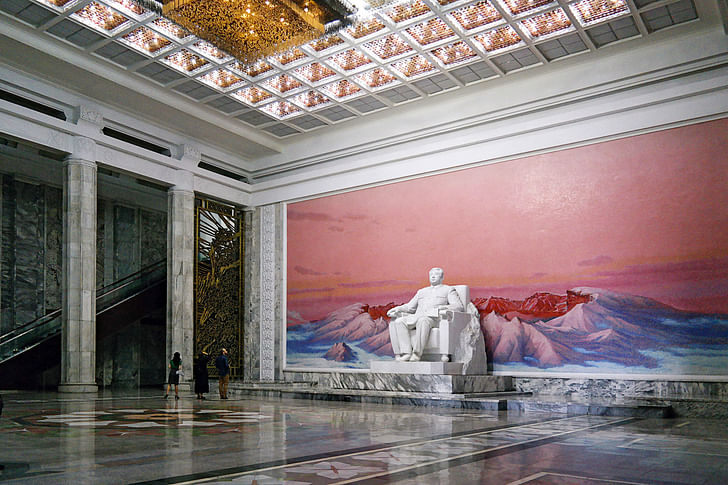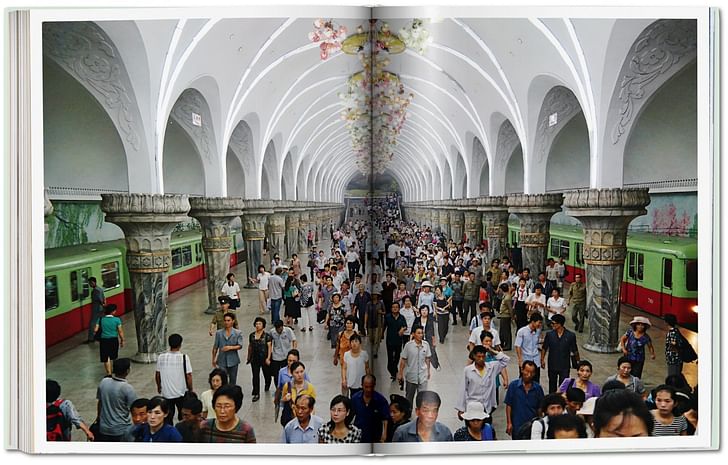

Now available at Archinect Outpost, Inside North Korea is the ambitious new book from British journalist Oliver Wainwright. I spoke to Wainwright about the making of the book and how he extended his journalistic talents to become its principal photographer. Though North Korea had long been a subject of interest to Wainwright, he had the chance in our interview to expand on how similar its architectural techniques are to those more familiar in Western practice.
How do you feel the photographic research developed for Inside North Korea ties into your larger research interests?
My broad journalistic and research interests are focused on examining the forces that shape our built environment – untangling the political, sociological and economic powers that lead to particular kinds of buildings and spaces.
It is a place built as an ideological tool, a city designed to mould its citizens’ behavior like no other place on the planet.
I was very interested in North Korea, and Pyongyang in particular, as a place that was shaped by a very specific ideology, and which continues to be governed by exactly the same ruling forces that first founded it in the 1950s. It is therefore unlike any other place in the world, entirely cut off from the usual changes of political regimes and commercial forces that change cities over time. It is a place built as an ideological tool, a city designed to mold its citizens’ behavior like no other place on the planet.
Both Kim Il Sung and Kim Jong Il were exceptionally aware of the power of architecture and urban planning to cement their regime and build a cult of personality around the ruling family, so it is a fascinating case study in how urban space and architectural form can be used as such a powerful ideological tool.
How did you decide to be the researcher, writer and photographer for the book?
The idea for the book actually came later. When I went to North Korea in 2015, it was with the intention of writing a long feature for the Guardian on the architecture and development of Pyongyang. I took thousands of photographs during the trip some of which were just to illustrate my article. I then set up a Tumblr blog on my return home, called North Korean Interiors, which was popularly shared online – that’s what sparked the idea for the book with Taschen. I then did a lot more research for the introductory essay and texts in the book.
Can you give an example of something you learned about North Korea only by visiting? Did the country surprise you based on prior knowledge?
The most surprising thing was how colorful the country is. From Western media, one imagines a place of relentless grey concrete blocks and windswept public squares for military parades, but Pyongyang is one of the most colorful cities I have ever visited. There are many generic concrete apartment blocks, but they are all painted in pastel hues of baby blue and terracotta, ochre and minty green, as if someone has emptied a packet of sugary pastilles across the city. The pastel palettes continue inside too, where interior spaces are always composed with the surreal symmetry of a Wes Anderson movie set.
I think there are various reasons for the use of color. In Kim Il Sung’s guidance to architects, he specified that they must look closely at historic Korean culture, and I think the colors have a lot to do with that. The common pale green color used on many facades and interiors could be a reference to the famous Celadon porcelain glaze, while the use of contrasting complementary colors is also something that can be found in ancient Korean temples. I also think you find very similar contrasting color combinations in the traditional Korean Hanbok – a turquoise dress matched with a salmon-colored jacket, or a pink dress with a blue jacket. These are the kinds of complementary colors you find through North Korean architecture.
From Western media, one imagines a place of relentless grey concrete blocks and windswept public squares for military parades, but Pyongyang is one of the most colorful cities I have ever visited.
Did you feel that the theatricality of the North Korean interior differs from that of Western architecture?
The interiors of most public buildings in North Korea are designed to encourage veneration of the leaders, whose portraits hang on a wall in every room. In their design and layout they are very similar to the interiors of Christian churches: there is always a central ‘nave’, often flanked by marching rows of columns, with seating either side, so your gaze is directed towards the end of this grand central axis to a statue or portrait of the leaders – in the same position as where the crucifix or depiction of Christ would be.
The similarity is no coincidence: Kim Il Sung came from a very Christian background. Indeed, Pyongyang used to be known as the “Jerusalem of the East” because of the number of churches in the city. Kim clearly learned a lot from religious architecture, and supplanted Christian ideas with his own Juche ideology – Kim Il Sung is seen as the equivalent of God, while Kim Jong Il is the Christ-like figure.
Sadly, many of the interiors of this early post-war period are being progressively ripped out in favor of styles that they think are “more modern”, mainly using materials imported from China, diluting their very specific Korean character in the process.
Many of the interiors also have a very Soviet feel, due to the number of North Korean architects who were trained in Moscow. Sadly, many of the interiors of this early post-war period are being progressively ripped out in favor of styles that they think are “more modern”, mainly using materials imported from China, diluting their very specific Korean character in the process.
Are there any similar research projects you would like to pursue in the future?
There are many. I’m drawn to places that have been shaped by very particular political or economic ideologies, and I’m working on a number of projects in this vein… stay tuned!

2 Comments
There is little doubt that there is much propaganda in the DPRK, but also in the US - just by different means.
Unfortunately Wainright omitted some of North Korea's most pertinent history - the loss of 1/3 of its population in the Korean War and the extreme conditions fostered upon it by the US ever since. 65 years later there is still no peace treaty. It has been disclosed that the US, after bombing the country back to the Stone Age (more tonnage of bombs was dropped on North Korea in two years than in all of WWII), biological warfare in the form of plague and other agents were also used.
Any discussion of historical effects on architecture that omits these facts is at best incomplete - and at worst propaganda.
ref: https://medium.com/insurge-int...
For more insight I reccomend I.F. Stone's The Hidden History of the Korean War.
You also need to compare the effect on quality of life of communism in the north vs capitalism in the south.
Block this user
Are you sure you want to block this user and hide all related comments throughout the site?
Archinect
This is your first comment on Archinect. Your comment will be visible once approved.